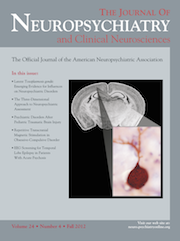Relationship Between Neuropsychiatric Symptoms and Cognitive Performance in De Novo Parkinson’s Disease
To the Editor: Parkinson's disease (PD) is regarded as a primary movement disorder, but is also characterized by nonmotor symptoms such as cognitive impairment and neuropsychiatric disturbances.1 Affective features such as depression and anxiety especially, may sometimes precede the clinical motor onset. Considering that dopaminergic treatments adopted to ameliorate motor symptoms may affect both cognitive performances and neuropsychiatric symptoms of PD patients,2 we aimed at investigating their relationships in newly diagnosed, drug-naïve (de novo) PD patients.
We administered a neuropsychiatric battery and a neuropsychological battery to 30 consecutive patients who recently received a clinical diagnosis of PD; all patients were assessed before the administration of any dopaminergic therapy. Informed consent was obtained in compliance with research standards for human research for all participating institutions and in accordance with the Helsinki Declaration. Patients were enrolled in an Italian movement disorder tertiary clinic (Versilia Hospital, Viareggio) and fulfilled research diagnostic criteria for idiopathic PD.3 The neuropsychiatric battery included the Toronto Alexithymia Scale, the Geriatric Depression Scale Short Form (GDS-15), the Barratt Impulsiveness Scale, the Maudsley Obsessive-Compulsive Questionnaire, and the Hamilton Rating Scale for Anxiety. The neuropsychological battery assessed verbal memory (Rey Auditory Verbal Learning Task [RAVLT]), visuospatial processing (Benton’s Judgment of Line Orientation Test, Raven Colored Progressive Matrices), executive functions (Frontal Assessment Battery, verbal fluency tasks), naming (Boston Naming Test), and constructional praxis (Rey-Osterrieth Complex Figure Copy Test).
Ten patients presented depressive symptoms; 6 patients, alexithymia symptoms; 6 patients, anxious symptoms; and 3 patients, impulsive symptoms. Although all de novo PD patients were found not to have dementia, 8 patients showed impaired performance on at least one cognitive task. Patients with depressive symptoms were older (p <0.05), with higher scores on the UPDRS-II (p <0.05), and with more memory difficulties at the RAVLT Delayed Recall (p <0.05) than patients without depressive symptoms. The GDS-15 correlated with age (r=0.429; p <0.05), the UPDRS-II (r=0.469; p <0.05), the RAVLT Immediate Recall (r = −0.400; p <0.05), the RAVLT Delayed Recall (r=−0.410; p <0.05). The TAS-20 correlated with the RAVLT Immediate Recall (r=−0.515; p <0.01). The MOCQ-R correlated with age (r=0.394; p <0.05), the FAB (r=−0.411; p <0.05), and with semantic verbal fluency (r=−0.502; p <0.01).
This study provided empirical evidence that some affective symptoms (depression, alexithymia, and anxiety) are common in the early, untreated clinical stages of PD, whereas impulsive and obsessive-compulsive symptoms are less common. As regards the relationship between cognitive performance and neuropsychiatric symptoms, both depressive and alexithymic symptoms were associated with poorer performances in episodic memory tasks, whereas obsessive-compulsive symptoms were associated with poorer performance on executive tasks (Frontal Assessment Battery and semantic verbal fluency). These findings confirm 1) the negative influence of affective symptoms on episodic memory;4 and 2) the association between obsessive-compulsive symptoms and frontal-subcortical circuitry dysfunction.5 In conclusion, this brief report evidenced specific correlations between neuropsychiatric symptoms and cognitive performance in patients at early, untreated, symptomatic PD stages: further longitudinal studies are needed to verify whether and how dopaminergic drugs modify these specific neuropsychiatric–cognitive relationships.
1 : Neuropsychiatric symptoms in Parkinson’s disease. Mov Disord 2009; 24:2175–2186Crossref, Medline, Google Scholar
2 : Dopaminergic modulation of cognitive function: implications for L-dopa treatment in Parkinson’s disease. Neurosci Biobehav Rev 2006; 30:1–23Crossref, Medline, Google Scholar
3 : Accuracy of clinical diagnosis of idiopathic Parkinson’s disease: a clinico-pathological study of 100 cases. J Neurol Neurosurg Psychiatry 1992; 155:181–184Crossref, Google Scholar
4 : The cognitive neuropsychology of depression in the elderly. Psychol Med 2007; 37:1693–1702Crossref, Medline, Google Scholar
5 : Frontal-subcortical circuitry and behavior. Dialogues Clin Neurosci 2007; 9:141–151Medline, Google Scholar



